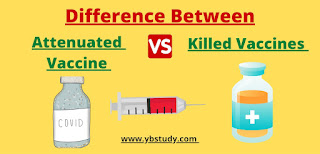5 Major Differences Between Live Attenuated and Killed Vaccines
Vaccines are made from inactivated pathogenic microorganisms or their metabolites
Live attenuated vaccines are vaccines prepared from artificially attenuated or avirulent strains selected from nature.
What are Inactivated Vaccines?
- Vaccines are made from inactivated pathogenic microorganisms or their metabolites.
- After the virus grows and reproduces in cells, it loses its pathogenic ability (inactivated) by adding chemicals, but still retains its immunogenicity.
- Inactivated bacteria or viruses are purified by various methods and then adsorbed with suitable adjuvants to prepare vaccines.
- The advantage of inactivated vaccine is that it can directly cause an immune response after entering the human body, and it cannot grow and reproduce.
- It is relatively safe and stable, but it requires multiple injections to generate a relatively strong immunity.
- The pertussis vaccine, diphtheria toxoid, mixed preparation of tetanus toxoid, and inactivated Japanese encephalitis vaccine belong to this category of preparations, as do genetically engineered recombinant antigen vaccines (such as hepatitis B virus vaccine).
What is a Live Attenuated Vaccine?
- Live attenuated vaccines are vaccines prepared from artificially attenuated or avirulent strains selected from nature.
- After inoculation of the human body, the live attenuated vaccine proliferates in a limited or transient manner in the appropriate tissue system, similar to a light artificial natural infection process, thereby causing an immune response similar to an infectious disease, but without the disease.
- The advantages of live attenuated vaccines are that they have a long action time in the human body, require fewer vaccinations, and can produce relatively strong immunity.
- The disadvantage is that the live attenuated vaccine is unstable to heat and usually needs to be made into a freeze-dried preparation, which is not easy to store and transport.
- Oral live attenuated polio vaccine and live attenuated measles vaccine belong to this category of preparations
5 Major Differences Between Live Attenuated and Killed Vaccines
| Attenuated Vaccine | Killed Vaccines |
|---|---|
| Attenuated Vaccines are also known as live vaccines. | Inactivated Vaccines are also known as dead vaccines. |
| Live, attenuated vaccines contain living pathogens. | Inactivated vaccines contain a killed version of the pathogen. |
| A live attenuated vaccine is a live vaccine made by reducing the virulence of the virus by some methods. | Inactivated/Killed vaccine is a vaccine made of a deadly virus, which can stimulate immunity. |
| The live attenuated vaccine is not easy to transport and preserve because it is a live vaccine. | The inactivated vaccine is relatively easy to transport and preserve because it is a dead vaccine. |
| A single dose of vaccine is sufficient to boost immunity. | Multiple doses are required to boost immunity. |
| Live vaccines produce long-term immunity. | Killed vaccines produce short-term immunity. |
| Examples of live vaccines are Measles, mumps, and chicken pox vaccines, etc. | Examples of inactivated vaccines are hepatitis A, inactivated poliovirus (IPV) vaccine, whooping cough vaccine, rabies vaccine, etc. |

